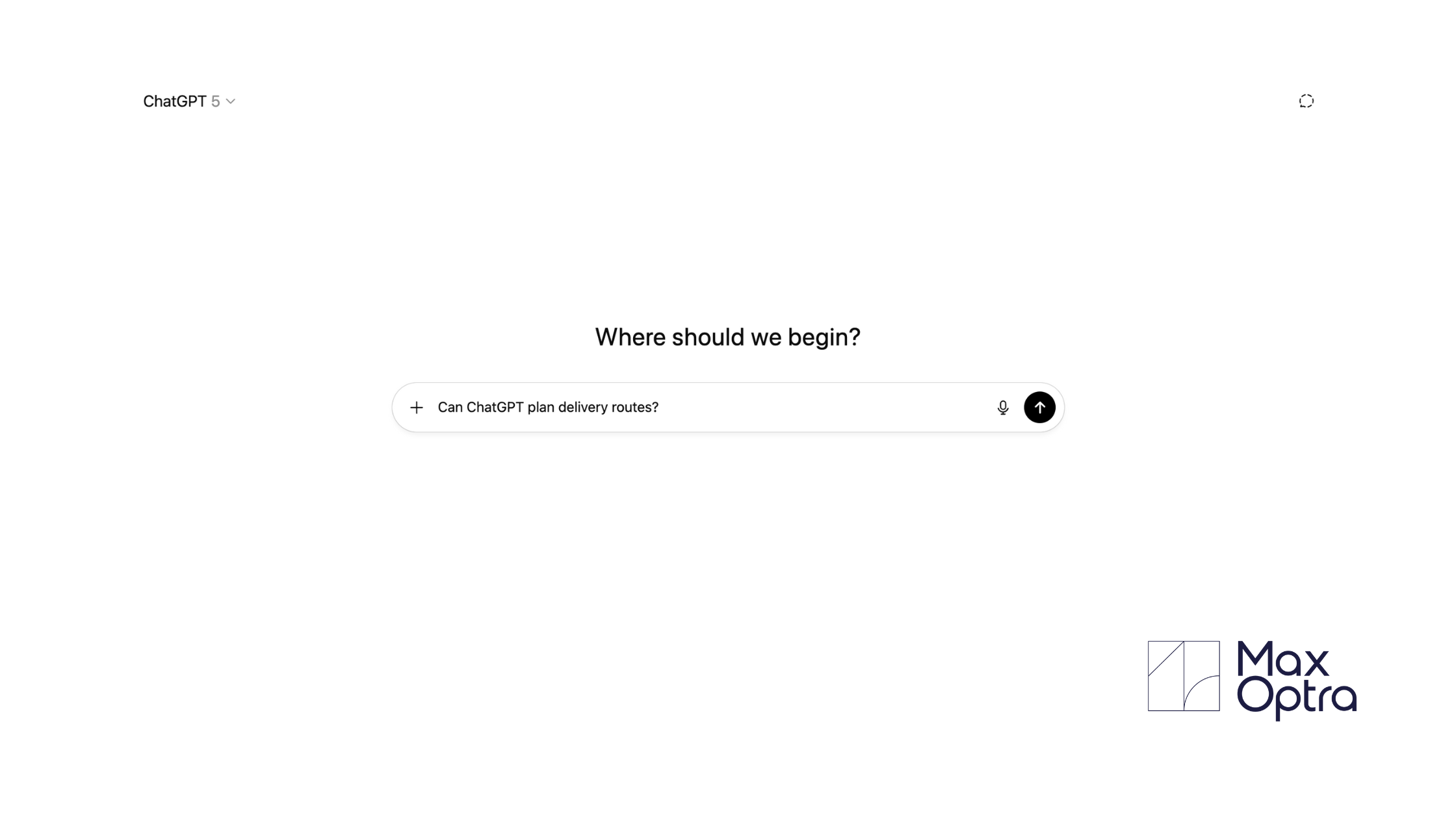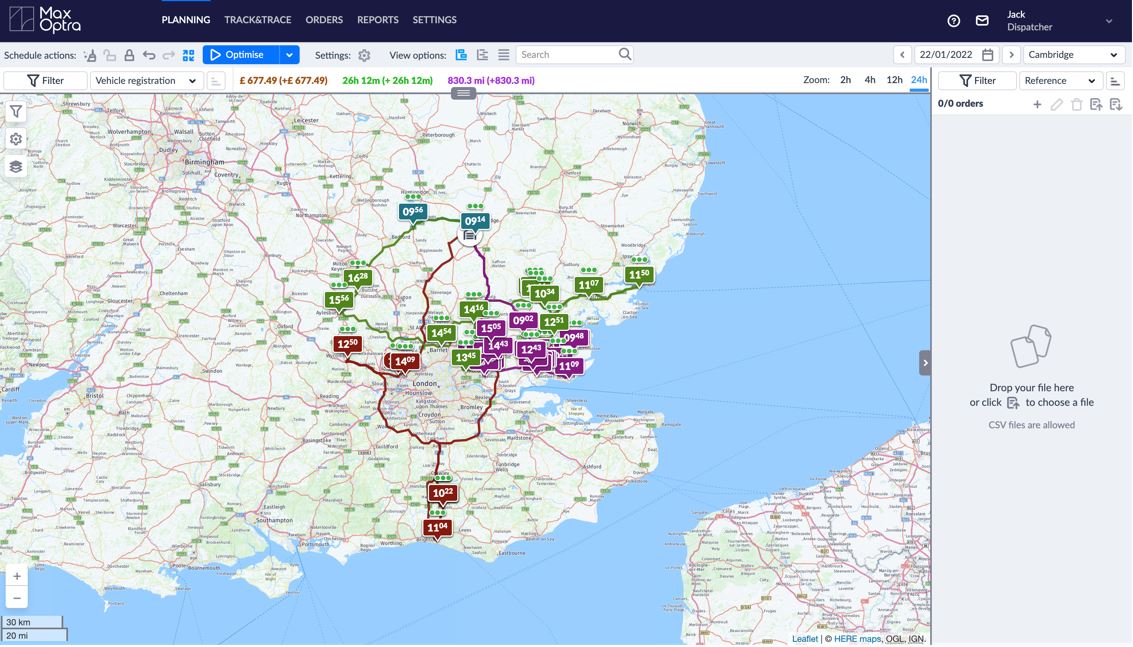Can ChatGPT Plan Delivery Routes?

Unless you’ve been living under a rock, you’ve probably heard about ChatGPT: the AI chatbot that can answer questions, write content, and even help plan your day. But what about logistics? Can ChatGPT plan delivery routes?
The short answer is yes, but only in a limited way. ChatGPT can help brainstorm basic routes, suggest a possible order of stops, and even provide rough travel estimates. However, when it comes to reliable, efficient, and scalable route planning for business deliveries, the longer answer is more complex.
This post explores how ChatGPT can support route planning, where it falls short, and why investing in a dedicated route optimisation solution is often the smarter choice for businesses that want to grow.
How ChatGPT can help with planning delivery routes

ChatGPT wasn’t designed as a mapping tool, but its ability to process information quickly makes it surprisingly useful in certain situations. If you paste in a list of addresses, the chatbot can arrange them into a logical order, suggest a possible sequence of visits, or provide a rough idea of travel times between stops. This makes it a handy option if you want a quick answer without jumping between mapping apps or spreadsheets.
For individuals or micro-businesses, this can remove a lot of manual guesswork. ChatGPT can plan delivery routes if your requirements are fairly simple, with just a handful of addresses to consider. It won’t replace navigation tools, but it can give you a clear written plan to work from.
Examples of use cases include:
– A local tradesperson with two or three jobs in different locations who just wants a quick way to decide the best order.
– A self-employed dog walker who needs to plan a sensible walking order for their daily clients.
– A one-person florist delivering bouquets around town without the budget for specialist software.
👍 The pros of using ChatGPT for planning delivery routes
If you’re running a very small operation, there are clear benefits to using ChatGPT for basic planning. It removes some of the mental load of working out logistics and helps you create a structured plan in minutes.
– Free to use (on the basic version)
– Quick to access via browser or app
– Flexible – you can ask questions in plain English and get a human-readable answer
– A time-saver for small-scale, low-pressure delivery routes
👎 The cons of ChatGPT & why businesses should be cautious
While ChatGPT can be useful, it’s important to understand what it cannot do. The chatbot doesn’t connect to live data sources or specialised algorithms, meaning its answers are more of a rough guide than a precise plan.
For anything beyond a few stops, these limitations quickly become clear:
– No live traffic data to avoid congestion or delays
– No integration with maps or GPS for real-time navigation
– No optimisation algorithms to calculate the fastest or most efficient sequence
– A higher chance of inaccurate travel times
– No operational features such as proof of delivery or customer notifications
These gaps mean that ChatGPT can be a good starting point, but it isn’t robust enough to support businesses where efficiency, punctuality, and customer communication matter.
Why Route Optimisation Software is the smarter option

Can ChatGPT plan delivery routes when requirements grow more complex, including multiple stops, multiple drivers, or strict time windows? In these cases, a purpose-built route optimisation solution will always perform better than a general-purpose chatbot. These platforms are designed to reduce wasted time, cut costs, and improve service quality.
🧠 Smarter Route Optimisation
Instead of producing a rough order of stops, route optimisation software analyses your address list and creates the most efficient routes automatically. It considers:
– Distance between stops
– Real-time traffic conditions
– Customer-specific delivery time windows
For teams managing several drivers, the system can optimise all routes simultaneously and adapt instantly if plans change during the day. This creates shorter, more efficient journeys, lowers fuel costs, and keeps customers happy.
💬 Real-time tracking and customer communication
Modern delivery expectations go beyond “it will arrive today.” Customers want accurate time slots, live tracking, and proactive updates. A good route optimisation solution allows you to:
– Send automated SMS or email updates with estimated delivery times
– Offer live tracking links so customers can see their order en route
– Reduce inbound calls asking “where’s my order?”
The result is higher customer satisfaction and stronger trust in your service.
👍 Easier adoption than you might expect
Some businesses hesitate to adopt new systems because of the learning curve.
However, most route optimisation platforms are designed for quick set-up, with intuitive interfaces, step-by-step onboarding, and integrations with popular CRMs, ERPs, and e-commerce platforms. This means you can start seeing benefits within days, not weeks.
💰 Cost management and ROI
While software does involve a subscription fee, the return is often immediate. By cutting unnecessary mileage, boosting driver productivity, and reducing time spent on customer service, the savings usually outweigh the costs. Many providers also offer scalable pricing so you only pay for what you need.
🤝 Support when you need it
Unlike free online tools, route optimisation software usually includes support and resources to help you get the most from the system. That might mean dedicated account management, a helpdesk, or a library of self-serve guides and tutorials.
🔒 Data security and compliance
One overlooked issue with AI chatbots is data handling. ChatGPT wasn’t built with GDPR compliance in mind, and pasting customer details into it can pose risks. Route optimisation platforms, on the other hand, are designed with data security built in, giving you peace of mind when handling sensitive information.
🪴 Flexibility as you grow
Perhaps the biggest advantage of investing in proper route planning software is future-proofing. As your business grows, adding new drivers, serving larger areas, or offering same-day delivery, a good solution can scale with you, preventing the need for constant system changes.
✅ Why the upgrade makes sense
ChatGPT is useful for planning delivery routes shortcut for sole traders or businesses with very light delivery schedules. But for organisations that rely on punctuality, efficiency, and customer communication, the gaps are too large to ignore. A dedicated route optimisation solution brings structure, accuracy, and reliability to an area of your business where mistakes are costly.
If saving time, cutting costs, and delivering a better customer experience are on your priority list, then moving beyond basic AI route planning is a logical next step.
FAQs – Can ChatGPT plan delivery routes?
Can ChatGPT replace route optimisation software?
No. While it can suggest a delivery order, it doesn’t provide live traffic updates, secure data handling, or operational tools like proof of delivery and driver allocation.
Does ChatGPT have access to Google Maps or GPS data?
No. ChatGPT can’t integrate with live maps or GPS tracking systems.
Is ChatGPT accurate for delivery route planning?
It can offer a reasonable starting point, but without live data and advanced optimisation, it’s not the most reliable method for business deliveries.
Who should use ChatGPT for route planning?
It’s most suitable for individuals or very small businesses making one or two of the same drops per day
What’s the best alternative for business deliveries?
A dedicated route optimisation platform like MaxOptra, which automates planning, manages multiple drivers, provides real-time tracking, and improves customer communication.
Final thoughts
So, can ChatGPT plan delivery routes?
The solution absolutely help, but only at the most basic level. If you’re serious about efficiency, reducing costs, and meeting customer expectations, a dedicated route optimisation solution is far more powerful and practical.
If you’d like to see how automated route optimisation could save you hours each week, learn more about MaxOptra’s here.
Maxoptra System
© MaxOptra, 2023. Privacy Policy and Cookies
